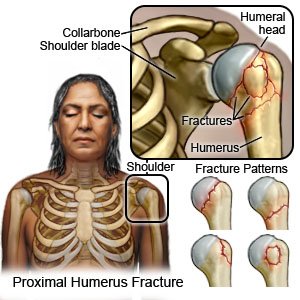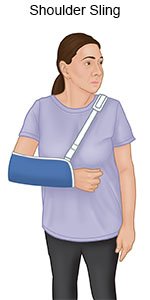Proximal Humerus Fracture
Medically reviewed by Drugs.com. Last updated on Aug 4, 2025.
AMBULATORY CARE:
A proximal humerus fracture
is a crack or break in the top of your upper arm bone. The proximal humerus is one of the bones in your shoulder joint.
 |
Common signs and symptoms include the following:
- Pain when you move your arm
- Swelling and bruising
- Trouble moving your shoulder
- Abnormal arm position or shape
- Weakness or numbness in your arm, hand, or fingers
Seek care immediately if:
- Your pain does not get better or gets worse, even after you rest and take medicine.
- Your arm, hand, or fingers feel numb.
- The skin over your fracture is swollen, cold, or pale.
- You cannot move your arm, hand, or fingers.
Call your doctor or orthopedist if:
- You have a fever.
- Your sling gets wet, damaged, or falls off.
- You have questions or concerns about your condition or care.
Treatment
depends on the type of fracture you have. You may need any of the following:
- A sling may be needed to hold your broken bones in place. It will decrease your arm movement and allow the bones to heal.

- Prescription pain medicine may be given. Ask your healthcare provider how to take this medicine safely. Some prescription pain medicines contain acetaminophen. Do not take other medicines that contain acetaminophen without talking to your healthcare provider. Too much acetaminophen may cause liver damage. Prescription pain medicine may cause constipation. Ask your healthcare provider how to prevent or treat constipation.
- NSAIDs , such as ibuprofen, help decrease swelling, pain, and fever. This medicine is available with or without a doctor's order. NSAIDs can cause stomach bleeding or kidney problems in certain people. If you take blood thinner medicine, always ask your healthcare provider if NSAIDs are safe for you. Always read the medicine label and follow directions.
- Acetaminophen decreases pain and fever. It is available without a doctor's order. Ask how much to take and how often to take it. Follow directions. Read the labels of all other medicines you are using to see if they also contain acetaminophen, or ask your doctor or pharmacist. Acetaminophen can cause liver damage if not taken correctly.
- Closed reduction may be done to put your bones back into the correct position without surgery.
- Surgery may be needed to put your bones back into the correct position. This is called open reduction. An incision is made and the bones are put back in the correct position. Wires, pins, plates, or screws may be used to hold the bones in place. For severe fractures, surgery to replace part of the shoulder joint with an artificial implant may be needed.
Manage your symptoms:
- Rest your arm as much as possible. Ask your healthcare provider when you can move your arm. Also ask when you can return to sports or vigorous exercises.
- Apply ice on your arm for 15 to 20 minutes every hour or as directed. Use an ice pack, or put crushed ice in a plastic bag. Cover it with a towel before you put it on your arm. Ice helps prevent tissue damage and decreases swelling and pain.
- Go to physical therapy as directed. A physical therapist teaches you exercises to help improve movement and strength, and to decrease pain.
Follow up with your doctor or orthopedist as directed:
Write down your questions so you remember to ask them during your visits.
© Copyright Merative 2025 Information is for End User's use only and may not be sold, redistributed or otherwise used for commercial purposes.
The above information is an educational aid only. It is not intended as medical advice for individual conditions or treatments. Talk to your doctor, nurse or pharmacist before following any medical regimen to see if it is safe and effective for you.
Further information
Always consult your healthcare provider to ensure the information displayed on this page applies to your personal circumstances.
